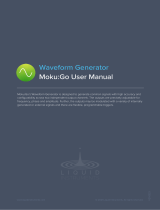
13 | Moku:Go Laser Lock Box User Manual © 2023 Liquid Instruments. All rights reserved.
Local oscillator
Configure the demodulation signal source in the settings dialog.
Demodulation
The demodulation mode determines which reference oscillator is used to demodulate the input
signal.
Modulation
The input signal can be demodulated with the modulation signal, which is user-configured here.
This local oscillator is locked to the modulation signal with a frequency range from 1 mHz to 30
MHz.
Internal
The input signal can be demodulated with an internally generated reference signal (independent
from modulation signal). This local oscillator is derived from the Moku:Go internal clock and thus
shares the same timebase. The frequency range of the internal reference is 1 mHz to 20 MHz.
External
The input signal can be demodulated by a direct external reference, permitting the use of non-
sinusoidal demodulation with the input signal applied on input 2.
External (PLL)
External (PLL) mode enables the Laser Lock Box to lock to an externally sourced demodulation
reference applied to input 2. This mode uses a digitally implemented phase-locked loop (PLL) to
track the phase of the external reference with a user configurable bandwidth. To configure the
bandwidth of the PLL, tap the PLL icon to select the bandwidth between 1 Hz to 100 kHz. The PLL
will automatically lock to the strongest harmonic of the external reference in the range of
10 Hz to 20 MHz with a manually configurable local phase shift. The PLL can be manually set as low
at 10 Hz. The PLL can be frequency multiplied up to 250x or divided down to 1/8x with the Multiplier
for use as local oscillator, minimum Multiplier step size is 1/8th. The reacquire button can be used to
relock to the external reference.
None
Bypass the demodulation step by selecting “None.” This enables modulation-free locking
techniques such as DC locking, fringe-side locking, and tilt locking.























